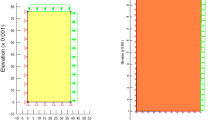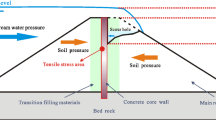Abstract
Effects of the first filling process of the Xiluodu super-high arch dam are studied by both field monitoring and numerical modelling methods. The numerical modelling is conducted by the three-dimensional nonlinear finite element method, which takes into account the nonlinear contact of the transverse joints between dam monoliths and adopts both the design and feedback parameters of the dam. The results obtained from the various numerical analysis cases for different impounded water levels are comprehensively compared with those obtained from the field monitoring. Throughout this study, it is concluded that: (1) changes of the hydrostatic load resulting from the filling process have a significant effect on the deformation and stress states of the dam and foundation. The foundation settles as a consequence of consolidation of the reservoir bed under the effect of the water mass. During the filling process, the compressive stress of the dam in the sealed region increases in the arch direction while that in the cantilever direction decreases, which reveals an enhancement of dam thrust into the two banks. (2) The transverse joints between the dam monoliths are compressed almost over the entire height of the poured dam, and their aperture gradually decreases as the impounded water level increases. (3) The overall deformation of the Xiluodu dam is obviously affected by the uneven foundation settlement due to the complex reservoir basin. The tensile stress concentration appears at the crossing zone of the top of the dam’s sealed region and the dam–foundation interface. Thus, reasonable layout of steel bars and suitable jointing design are essential in these tensile stress concentration regions. (4) The dam behaviour predicted using the three-dimensional numerical modelling is in good agreements with that from the field measuring in terms of the stress and strain distribution characteristics in the dam and foundation, especially when the feedback parameters are adopted for the numerical analysis. The results from both the field monitoring and numerical modelling reveal that overall stability of the dam during the first filling process meets the dam operational requirements.

















Similar content being viewed by others
Reference
Ahmadi MT, Razavi S (1992) A three-dimensional joint opening analysis of an arch dam. Comput Struct 44(1–2):187–192
Aleksandrovskaya ÉK (1986) Stress-strain state of the Sayano-Shushenskoe dam during filling of the reservoir. Hydrotech Constr 20(3):123–129
Aleksandrovskaya ÉK (1988) Static behavior of the Sayano-Shushenskoe data in the last stages of filling the reservoir. Hydrotech Constr 22(10):607–612
Aleksandrovskaya ÉK (1994) State of the Sayano-Shushenskoe dam during fourfold rise of the upper pool level to the elevation of the normal pool level. Hydrotech Constr 28(10):630–634
Araujo JD, Awruch AM (1998) Cracking safety evaluation on gravity concrete dams during the construction phase. Comput Struct 66(1):93–104
Baustadter K, Widmann R (1985) The behavior of the Kolnbrein arch dam, 15th ICOLD Proceedings, Lausanne, pp 633-651
Cela JJL (2002) Material identification procedure for elastoplastic Drucker-Prager model. J Eng Mech ASCE 128(5):586–591
Chen Y, Zhang L, Yang G, Dong J, Chen J (2012) Anti-sliding stability of a gravity dam on complicated foundation with multiple structural planes. Int J Rock Mech Min Sci 55:151–156
Cui HD, Zhu YM (2009) Theoretical model and numerical simulation by coupling unsteady seepage field with temperature field during initial impounding period of concrete dams. J Hydraul Eng 40(2):238–243
Dai F, Xia K (2013) Laboratory measurements of the rate dependence of the fracture toughness anisotropy of Barre granite. Int J Rock Mech Min Sci 60:57–65
Erwin SO, Schmidt JC, Nelson NC (2011) Downstream effects of impounding a natural lake: the Snake River downstream from Jackson Lake Dam. Wyoming, USA. Earth Surf Process Landf 36(11):1421–1434
Fei WP, Zhang L, Zhang R (2010) Experimental study on a geo-mechanical model of a high arch dam. Int J Rock Mech Min Sci 47(2):299–306
Fishman YA (2009) Stability of concrete retaining structures and their interface with rock foundations. Int J Rock Mech Min Sci 46(6):957–966
Han XF (2005) Study on effect of impounded water level on transverse joints aperture in high arch dam. Water Resour Power 23(4):38–40
Hibbitt D, Karlsson B, Sorensen P (2002) ABAQUS/Standard user's manual version 6.3. ABAQUS ltd, Providence
Ingraffea AR (1990) Case studies of simulation of fracture in concrete dams. Eng Fract Mech 35(1–3):553–564
Jaeger JC, Cook NGW, Zimmerman RW (2007) Fundamentals of rock mechanics (4th Edition), Blackwell Publishing
Jin F, Hu W, Pan J, Yang J, Wang J, Zhang C (2011) Comparative study procedure for the safety evaluation of high arch dams. Comput Geotech 38:306–317
Lin P, Li QB, Hu H (2012) A flexible network structure for temperature monitoring of a super high arch dam. Int J Distrib Sens Netw. doi:10.1155/2012/917849
Lin P, Li QB, Zhou SW, Hu Y (2013) Intelligent cooling control method and system for mass concrete. J Hydraul Eng 44(8):950–957
Lin P, Zhou WY, Liu HY (2014a) Experimental study on cracking, reinforcement and overall stability of the Xiaowan super-high arch dam. Rock Mech Rock Eng. doi:10.1007/s00603-014-0593-x
Lin P, Liu HY, Li QB, Hu H (2014b) Effects of outlets on cracking risk and integral stability of super high arch dams. Sci World J. doi:10.1155/2014/312827
Lin P, Liu XL, Zhou WY, Wang RK, Wang SY (2014c) Cracking, stability and slope reinforcement analysis relating to the Jinping dam based on a geomechanical model test. Arab J Geosci. doi:10.1007/s12517-014-1529-1
Lin P, Ma TH, Liang ZZ, Tang CA, Wang RK (2014d) Failure and overall stability analysis on high arch dam based on DFPA code. Eng Fail Anal 45:164–184. doi:10.1016/j.engfailanal.2014.06.020
Lin P, Huang B, Li Q, Wang R (2014e) Hazard and seismic reinforcement analysis for typical large dams following the Wenchuan earthquake. Eng Geol. doi:10.1016/j.enggeo.2014.05.011
Liu J, Feng XT, Ding XL, Zhang J, Yue DM (2003a) Stability assessment of the Three-Gorges dam foundation, China, using physical and numerical modelling—part I: physical model tests. Int J Rock Mech Min Sci 40(5):609–631
Liu J, Feng XT, Ding XL (2003b) Stability assessment of the Three-Gorges dam foundation, China, using physical and numerical modelling—part I: physical model tests. Int J Rock Mech Min Sci 40(5):633–652
Luo DN, Hu Y, Li QB (2013) Allowable height difference between Adjacent monoliths with spherical surface key groove in transverse joints. Appl Mech Mater 438:624–628
Luo DN, Lin P, Li QB, Wang C (2014) Performance analysis of Xiluodu super-arch dam in impounding period. J Hydraul Eng 45(1):18–26
Matheson DS, Morgenstern NR, Nussbaum H (1987) Design, construction and performance of the Nipawin dams. Canadian Geotechnical Conference, Proceedings of the 40th Canadian Geotechnical Conference, Regina, Sask, Can, pp 141-155
Moll S, Straubhaar R (2011) Performance of a high rockfill dam during construction and first impounding. Nam Ngum 2 CFR, Dams and Reservoirs under Changing Challenges, Proceedings of the International Symposium on Dams and Reservoirs under Changing Challenges—79 Annual Meeting of ICOLD, Swiss Committee on Dams, pp 65-72
Najib B, Patrick P, Jean P (2004a) Dynamic response of a concrete dam impounding an ice-covered reservoir: part I. Mathematical modelling. Can J Civ Eng 31(6):956–964
Najib B, Patrick P, Jean P (2004b) Dynamic response of a concrete dam impounding an ice-covered reservoir: part II. Parametric and numerical study. Can J Civ Eng 31(6):965–976
Okamoto S, Mizukoshi T, Miyata Y (1986) On the observations of microearthquake activity before and after impounding at the Takase Dam. A special report. Phys Earth Planet Inter 44(2):115–133
Oliveira S, Faria R (2006) Numerical simulation of collapse scenarios in reduced scale tests of arch dams. Eng Struct 28(10):1430–1439
Permyakova L, Epifanov A (2011) Formation of the stress-strain state of the dam at the Sayano-Shushenskaya HPP during 2010 filling of reservoir. Power Technol Eng 45(3):188–192
Raschke R, Angermeier A (1989) Project design, construction works and impounding phase of the Wupper Dam Project. Wasserwirtschaft 79(7–8):329–334
Savich A, Gaziev EG (2013) The effects of joint water in rock foundations of high dams. Int J Hydropower Dams 20(6):64–68
Sharan SK (1992) Efficient finite element analysis of hydrodynamic pressure on dams. Comput Struct 42(5):713–723
Sun SA, Xiang AM, Ping Z, Shen CY (2006) Gravity change and its mechanism after the first water impoundment in three gorges project. Acta Seismolo Gica Sinica 28(5):485–492
Tomida N, Sato N, Soda H, Jikan S, Ohmori K, Ohta H (2011) Estimation of rockfill dam behavior during impounding by elasto-plastic model. Dams and Reservoirs under Changing Challenges, pp 27-34
Wang J, Henkelmann B, Bi Y, Zhu K, Pfister G, Hu W, Temoka C, Westrich B, Schramm KW (2013) Temporal variation and spatial distribution of PAH in water of Three Gorges reservoir during the complete impoundment period. Environ Sci Pollut Res 20(10):7071–7079
Wen JX (1989) Characteristics and mechanist of deformation in the Gezhouba reservoir after retain water. Crustal Deform Earthq 9(2):35–41
Xu NW, Dai F, Liang ZZ, Zhou Z, Sha C, Tang CA (2014) The dynamic evaluation of rock slope stability considering the effects of microseismic damage. Rock Mech Rock Eng 47:621–642
Yu X, Zhou YF, Peng SZ (2005) Stability analyses of dam abutments by 3D elasto-plastic finite element method: a case study of Houhe gravity-arch dam in China. Int J Rock Mech Min Sci 42(3):415–430
Yuan H, Li DD, Zhang K (2013) Study on security risk of impounding safety in China's small reservoir. Adv Mater Res 798:1119–1122
Zelenevskii Z, Chalyi N (1981) First results of the operation of the arch dam of the Chirkey hydroelectric station. Power Technol Eng (formerly Hydrotechnical Construction) 15(12):715–724
Zhou J, Lin G, Zhu T, Jefferson AD, Williams FW (2000) Experimental investigations into seismic failure of high arch dams. J Struct Eng 126(8):926–935
Zhou W, Chang X, Zhou C, Liu X (2008) Failure analysis of high-concrete gravity dam based on strength reserve factor method. Comput Geotech 35:627–636
Zhou QJ, Zhang GX, Liu Y (2013) Prediction of and early warning for deformation and stress in the Xiaowan arch Dam during the first impounding stage. Appl Mech Mater 405–408:2463–2472
Zhu W, Li Y, Li S, Wang S, Zhang Q (2011) Quasi-three-dimensional physical model tests on a cavern complex under high in-situ stresses. Int J Rock Mech Min Sci 48(2):199–209
Acknowledgments
This research work was supported by National Natural Science Foundation of China (No: 11272178,51339003), National Basic Research Program of China (973 Program) Grant No. 2011CB013503, 2013CB035902, Tsinghua University Initiative Scientific Research Program. The authors are very grateful to the China Three Gorges Corporation and HydroChina Chengdu Engineering Corporation for supporting this study. The authors are very grateful to reviewers for their critical recommendations which helped the author to improve this paper significantly.
Author information
Authors and Affiliations
Corresponding author
Rights and permissions
About this article
Cite this article
Luo, D., Lin, P., Li, Q. et al. Effect of the impounding process on the overall stability of a high arch dam: a case study of the Xiluodu dam, China. Arab J Geosci 8, 9023–9041 (2015). https://doi.org/10.1007/s12517-015-1868-6
Received:
Accepted:
Published:
Issue Date:
DOI: https://doi.org/10.1007/s12517-015-1868-6




